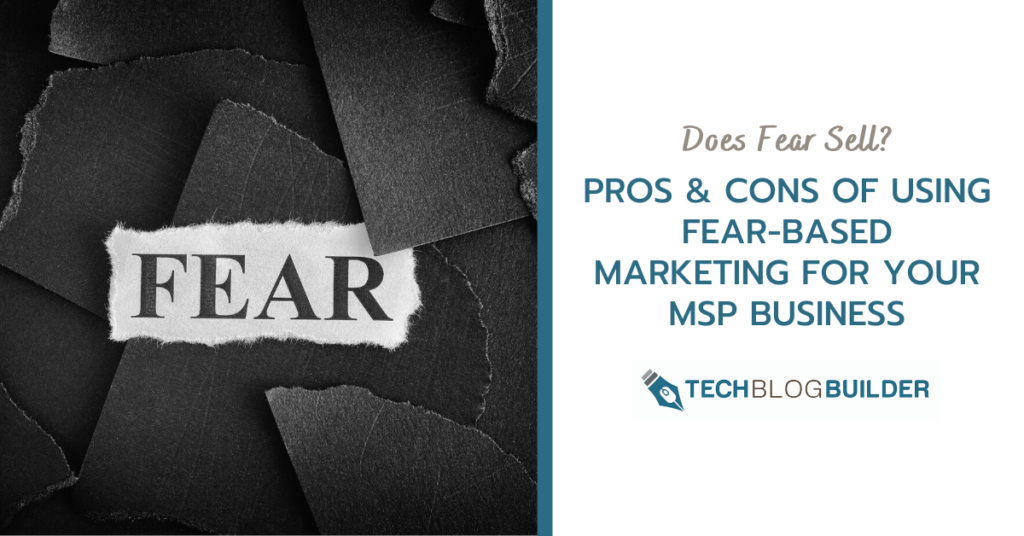Fear is one of the marketing tactics you’ll often see used in major ad campaigns, but does it really work or just scare people away?
Being afraid of something can be a motivator to take action, however it can also backfire on you if it’s not used correctly.
Is there a place for fear-based marketing in an MSP business? We’ll go through the pros, cons, and best practices to help you decide whether or not using this tactic is right for your marketing strategy.
The Psychology Behind Fear-Based Marketing
Advertising has long understood that emotions sell. Messages that can hit a certain emotional button will tend to trigger the desired action more than a message that’s neutral.
According to HubSpot, marketing content that uses purely emotional triggers performs 2x as well as using only rational content.
Fear is one of the major emotions that causes a “fight or flight” reaction. But is it the best emotion to target?
The trick is getting the desired reaction, rather than sending someone running from the blog you just posted.
Examples of Fear-Based Marketing
When you look over your managed IT services, one that stands out particularly well as a target for using fear as a motivator is cybersecurity.
Fear of a data breach or identity theft is a major factor that drives companies and individuals to buy cybersecurity products like antivirus software and firewalls or managed IT security services.
Here are two examples of using fear in marketing cybersecurity-related products:
Fear Example 1:
This first pitch, from Kaspersky uses a soft-touch approach, yet fear is still the motivator. The headline reads: “Stay Safe In Changing Times,” which directly relates to how 2020 has been anything but a typical year, and “stay safe” speaks directly to fear of the unpredictability of recent events.

Fear Example 2:
When it comes to LifeLock, they go directly for the fear centers of the brain to market the company’s identify theft services. LifeLock uses videos and quotes giving examples of someone that lost their job, another person that had their credit ruined, and another that had a loan taken out with their SSN.

Why Isn’t Everyone Using It?
One thing I noticed when looking for examples of fear-based marketing in the cybersecurity industry is that not everyone uses it. Well-known brands like McAfee and Avast prefer to trigger other, more positive emotions in their marketing.
Positive Example 1:
This example from McAfee uses comfort and peace of mind to trigger a positive feeling people get when they feel they’re protecting their loved ones. The headline states, “It’s more than just antivirus software – it’s peace of mind.”

Positive Example 2:
You get an immediate feeling of happiness and calm just from the image Avast uses in its antivirus marketing. The firm also chooses to trigger the comfort emotion rather than fear, with the heading, “Easy to install, effortless to use.”

So, who’s right?
We’ll go into the pros and cons of using fear-based and scare tactics for your MSP marketing next.
Pros: Why You Might Want to Consider Using Fear as a Trigger
As we’ve seen from the two fear-based marketing examples, not all fear marketing has to scare the heck out of someone. It can either be used on “full steam ahead” mode, like LifeLock does, or be scaled back, as in the case of Kaspersky’s “stay safe” headline.
There’s also an entirely different category of fear-based marketing called FOMO (fear of missing out), which is used often in those “Limited time, act now” offers.
But the type of scare-tactics we’re focusing on are those that cause someone to think they need a product or service you’re selling, because otherwise something bad will happen.
Why should you consider using fear in your content marketing to drive more leads and sales? Here are a few reasons.
It’s Aligned with the Scientific Principal of Loss Aversion
Loss aversion is a principal based upon multiple psychological studies that illustrate customers are more motivated by the fear of losing something than they are by gaining something.
In one of the studies on loss aversion, participants were shown a fictitious insecticide with a risk of 15 poisoning incidents per 10,000 bottles sold. They were then asked how much they’d pay to reduce the risk. They came up with a consensus of a little under $4.00.
But when asked how much of a price reduction they would accept for an increase in the poisoning risk, 77% of the respondents would not buy the product, no matter how cheap it was.
They were more afraid of losing something (taking a bigger health risk) than of gaining a monetary benefit.
It Can Make You Stand Out
Nothing grabs a person’s attention like a scary headline. That’s why you’ll often see more negative and fear-based headlines on news websites than positive ones.
If you’re trying to get your SEO optimized blog on ransomware to stand out among the crowd in a Google search result, a title that grabs the reader’s attention can mean more visits to your MSP business website.
Here are a few examples of article headlines that come up when searching “ransomware” on Google:
- “What Is Ransomware?”
- “Frequently Asked Questions – Ransomware”
- “Ransomware Attacks Grow, Crippling Cities and Businesses”
- “What Is Ransomware and How Do You Remove It?”
Which one creates an urgency to read the article? For most people, it’s number three, which sounds much scarier than the others.
It Can Lead to Higher Conversions in Some Cases
While not everyone’s experience is the same, when used correctly, motivating users by fear can lead directly to higher conversions.
In this example on NeilPatel.com related to PPC marketing, online advertising company WordStream tested a positive Google Ad against a negative, fear-based one.
Positive Ad Headline:
Free Google AdWords Grader – Get the Most Out of Your Ads
Negative Ad Headline:
Stop Wasting Money in AdWords – Use Our Simple & Free Tool
The fear-based Google Ad had a 70% higher click-through-rate and 18.8% higher conversion rate than the positive ad.
One reason could be that loss aversion principal. People were more motivated by a fear of losing money than they were motivated by getting more out of their ads.
Cons: Drawbacks of Using Fear in Your Tech Business Marketing
The benefits of using fear in marketing don’t always outweigh the negatives. When you try to inject scare tactics into your marketing content, it’s a bit like playing with fire, it’s easy for things to get out of hand.
Here are some of the cons of using fear-based marketing to promote your products and services.
It Can Turn People Off
Do you ever change the channel or walk out of the room when you see one of those commercials with sad music showing either malnourished children or mistreated animals?
It’s not because you don’t care, it’s often because you care so much that it’s painful to see.

Using scare-tactics can come back to bite you by actually driving people away from your content rather than encouraging them to read more.
Fear Doesn’t Always Work
Some of the most memorable ads using scare tactics are ones about drugs or smoking, such as the famous “your brain on drugs” showing eggs in a frying pan.
But while these ads may have garnered a lot of attention, studies showed that these types of fear-based ads didn’t get the intended results and were largely ineffective.
What this shows is that, while you may get lots of clicks from a scary headline, that doesn’t necessarily mean those people will buy anything.
It Can Hurt Your Brand Reputation
Some customers can easily feel put-off if you start using scare tactics in your content and it’s completely “off brand” from what they’re used to from your business.
You work hard to build a good brand reputation, and one headline that goes too far into the fear zone can cost you trust and business.
32% of consumers say they will stop doing business with a company they love after just a single bad experience.
It’s Easy to Go Overboard
It’s easy to go too far both with images and text used in fear marketing. You can come off as insensitive or out of touch. Taking scare tactics too far is somewhat like drinking a little too much at family gathering and telling an off-color joke. It’s something people will find hard to forget.
Here’s one example of a company going overboard with fear marketing and it back firing on them.
An anti-mold paint company purchased a full-page magazine ad. The ad showed a house with water covering the bottom 1/3 of the image. The tagline warned of the need to protect against mold damage by using mold resistant paint.
Unfortunately, this ad was put out just a few years after Hurricane Katrina, and the company received upset calls about the ad, which people considered callous and insensitive.
How to Successfully Use Fear as a Motivator in Marketing
When it comes to your content marketing, it’s important that it strike an emotional chord, otherwise it can just fall flat. And fear is a pretty major emotion, so you may not want to leave it out entirely. Just be careful how you use it.
Psychology Today has some great science-backed information that can be translated into how to do fear-marketing right.
There is a Maximum Fear Effect Value
After a moderate amount of fear is conveyed to the reader, you don’t get any additional benefit from piling more fear on top of that.
So, “a little goes a long way” is the takeaway here.
Use just a few words in your content that might elicit fear, but don’t make your entire ad or article a horror story.
Give the Audience Hope
Another takeaway mentioned by Psychology Today was that fear messages that also tell the audience how to avoid the “scary thing” fare better than those that just scare without any solution offered.
So, if you were creating a video introducing your new branded VoIP service, you’d want to not only say:
“Your phone company is ripping you off! Higher costs and less features.”
You’d also want to add the hope with something like:
“You can save tons of money and do more by switching to a VoIP system.”
Balance Negative with Positive Emotions
Fear not only provokes a fear reaction, it can also cause people to feel things like anger, disgust, anxiety, or guilt. You can keep yourself from going too far and turning off your audience with a mix of negative emotions, by adding a positive emotional balance.
Here’s an example:
“Cyberattacks on Small Businesses are Rising – But You Can be Prepared”
In the headline above the fear is balanced by a hopeful message telling someone they can be prepared, hence everything will be okay. Before they careen off into several negative emotions, you’ve steered them back to positive territory.
Always Use it Ethically
One of the dangers of using fear marketing is it goes too far and is seen as unethical by the reader. In the case of the anti-mold paint company, while it technically wasn’t unethical to use that ad, some consumers thought it was, or at the very least, incredibly uncaring.
You don’t want to just scare someone for the sake of “click bait” that can run up short-term numbers, but leave you looking like a used car salesman.
Instead, you want to always come from a good place when applying fear to your MSP business marketing, meaning you want to warn so you can help them protect or avoid negative impacts related to technology.
Use Fear Sparingly, Gain Big Benefits
It’s a positive to try new things in your content marketing and advertising, you may find something that hits the right chord and drives more leads. Just use fear tactics sparingly and come from a place of helping to solve a problem.
Have you mastered fear-based marketing in a blog or ad? Let us know in the comments!



5 responses to “Does Fear Sell? Pros & Cons of Using Fear-Based Marketing for Your MSP Business”
Yes, it’s been 18 months since you (Matt) published this piece on fear tactics in marketing, but one point triggered my reply. You have actually given credence and validation to those who would YEARS after Katrina somehow make an equation between the water-logged visual and the hurricane. And further, you seemed to recommend taking these people into consideration when designing an ad. Nuts. You’ll never hear from those who got the message and bought the paint. If you did, you’d never give these whiners the time of day, let alone blog ink. Even had the paint company run that ad two weeks after Katrina they’d just be taking advantage of a top-of-mind news item. But years? They deserve exoneration on the basis of a statute of limitations on hypersensitivity.
You could definitely see your skills in the work you write.
The world hopes for even more passionate writers like you who aren’t afraid
to mention how they believe. All the time follow your heart.
Touche. Great arguments. Keep up the great spirit.
Having read this I thought it was really enlightening.
I appreciate you taking the time and effort to put this informative article together.
I once again find myself spending a significant
amount of time both reading and posting comments. But so what, it was still
worthwhile!
Feel free to surf to my web page – складчина
Heya i am for the first time here. I found this board and I
find It truly useful & it helped me out much.
I hope to give something back and help others like you aided me.